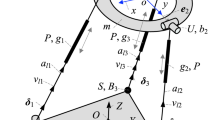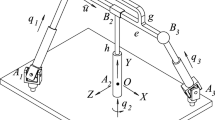Abstract
In this work the hyper-jerk analysis of robot manipulators is addressed by means of the theory of screws. The reduced hyper-jerk state of a rigid body as observed from another body or reference frame is obtained as a six-dimensional vector by applying the concept of helicoidal vector field. Moreover, this contribution demonstrates that the reduced hyper-jerk state of a rigid body can be considered, similar to the velocity state, as a twist about a screw. Furthermore, the reduced hyper-jerk state is systematically obtained in pure screw form. Finally, a case study, which is verified with the aid of commercially available software, that consists of solving the kinematics, up to the hyper-jerk analysis, of a zero-torsion parallel manipulator is included in order to show the application of the method of kinematic analysis.
Similar content being viewed by others
References
Ball, R.S.: A Treatise on the Theory of Screws. Cambridge University Press, Cambridge (1900, reprinted 1998)
Brand, L.: Vector and Tensor Analysis. Wiley, New York (1947)
Rico, J.M., Duffy, J.: An application of screw algebra to the acceleration analysis of serial chains. Mech. Mach. Theory 31, 445–457 (1996)
Rico, J.M., Gallardo, J., Duffy, J.: A determination of singular configurations of serial non-redundant manipulators, and their escapement from singularities using Lie products. In: Merlet, J.-P., Ravani, B. (eds.) Computational Kinematics ’95, pp. 143–152. Kluwer, Dordrecht (1995)
Rico, J.M., Gallardo, J.: Acceleration analysis, via screw theory and characterization of singularities of closed chains. In: Lenarčič, J., Parenti-Castelli, V. (eds.) Recent Advances in Robot Kinematics, pp. 139–148. Kluwer, Dordretch (1996)
Gallardo-Alvarado, J., Orozco-Mendoza, H., Rodríguez-Castro, R., Rico-Martínez, J.M.: Kinematics of a class of parallel manipulators which generates structures with three limbs. Multibody Syst. Dyn. 17, 27–46 (2007)
Gallardo, J., Orozco, H., Rico, J.M.: Kinematics of 3-RPS parallel manipulators by means of screw theory. Int. J. Adv. Manuf. Tech. 36, 598–605 (2008)
Gallardo-Alvarado, J., Alici, G., Pérez-González, L.P.: A new family of constrained redundant parallel manipulators. Multibody Syst. Dyn. 23, 57–75 (2010)
Rico, J.M., Gallardo, J. and Duffy, J.: Screw theory and higher order kinematic analysis of open serial and closed chains. Mech. Mach. Theory 34, 559–586 (1999)
Gallardo-Alvarado, J., Rico-Martinez, J.M.: Jerk influence coefficients, via screw theory, of closed chains. Meccanica 36, 213–228 (2001)
Gallardo-Alvarado, J.: Jerk distribution of a 6-3 Gough-Stewart platform. Proc. Instn. Mech. Engrs. Part K: J. Multi-body Dyn. 217, 77–84 (2003)
Gallardo-Alvarado, J.: Jerk analysis of a six-degrees-of-freedom three-legged parallel manipulator. Robot. Cim-Int Manuf. 28, 220–226 (2012)
Lipkin, H.: Time derivatives of screws with applications to dynamic and stiffness. Mech. Mach. Theory 4, 259–273 (2005)
Viviani, P., Schneider, R.: A developmental study of the relationship between geometry and kinematics in drawing movements. J. Exp. Psychol. Hum. Percept. Perform. 17, 198–218 (1991)
Balasubramaniam, R., Wing, A.M., Daffertshofer, A.: Keeping with the beat: movement trajectories contribute to movement timing. Exp. Brain Res. 159, 129–134 (2004)
Fradet, L., Lee, G., Dounskaia, N.: Origins of submovements in movements of elderly adults. J. NeuroEngineering Rehabil. 5, 28 (2008)
Safronov, V.A.: Chaotic and ordered processes mediating the knee-jerk reflex. Hum. Physiology 35, 306–315 (2009)
Piazzi, A., Visioli, A.: Global-minimum-jerk trajectory planning of robot manipulators. IEEE Trans. Ind. Electron. 47, 140–149 (2000)
Bruijnen, D., van Helvoort, J., van de Molengraft, R.: Realtime motion path generation using subtargets in a rapidly changing environment. Robot. Auton. Syst. 55, 470–479 (2007)
Gasparetto, A., Zanotto, V.: A new method for smooth trajectory planning of robot manipulators. Mech. Mach. Theory 42, 455–471 (2007)
Bagci, C.: Synthesis of double-crank (drag-link) driven mechanisms with adjustable motion and dwell time ratios. Mech. Mach. Theory 12, 619–638 (1977)
Barre, P.-J, Bearee, R., Borne, P., Dumetz, E.: Influence of a jerk controlled movement law on the vibratory behaviour of high-dynamics systems. J. Intell. Robot. Syst. 42, 275–293 (2005)
Naskar, T.K., Acharyya, S.: Measuring cam-follower performance. Mech. Mach. Theory 45, 678–691 (2010)
Macfarlane, S., Croft, E.: Jerk-bounded manipulator trajectory planning: design for real-time applications. IEEE Trans. Robot. Autom. 19, 42–52 (2003)
Dumetz, E., Dieulot, J.-Y., Barre, P.-J., Colas, F., Delplace, T.: Control of an industrial robot using acceleration feedback. J. Intell. Robot. Syst. 46, 111–128 (2006)
Boryga, M., Grabos, A.: Planning of manipulator motion trajectory with higher-degree polynomials use. Mech. Mach. Theory 44, 1400–1419 (2009)
Bearee, R., Barre, P.-J., Bloch, S.: Influence of high-speed machine tool control parameters on the contouring accuracy. Application to linear and circular interpolation. J. Intell. Robot. Syst. 40, 321–341 (2004)
Xu, R.Z., Xie, L., Li, C.X., Du, D.S.: Adaptive parametric interpolation scheme with limited acceleration and jerk values for NC machining. Int. J. Adv. Manuf. Tech. 36, 343–354 (2008)
Wan, D., Wang, S.L., Zhu, C.C., Meng, F.: Feedrate scheduling and jerk control algorithm for high-speed CNC machining. Int. J. Adv. Manuf. Manag. 17, 216–231 (2009)
Sugimoto, K., Duffy, J.: Application of linear algebra to screw systems. Mech. Mach. Theory 17, 73–83 (1982)
Hunt, K.H.: Structural kinematics of in-parallel-actuated robot arms. ASME J. Mech. Trans. Aut. Des. 105, 705–712 (1983)
Lee, K.M., Shah, D.K.: Kinematic analysis of a three-degree-of-freedom in-parallel actuated manipulator. IEEE J. Robot. Autom. 4, 354–360 (1988)
Huang, Z., Fang, Y.F.: Kinematic characteristics analysis of 3 DOF in-parallel actuated pyramid mechanism. Mech. Mach. Theory 31, 1009–1018 (1996)
Kim, H.S., Tsai, L.-W.: Kinematic synthesis of a spatial 3-RPS parallel manipulator. ASME J. Mech. Des. 125, 92–97 (2003)
Liu, C.H., Cheng, S.: Direct singular positions of 3RPS parallel manipulators. ASME J. Mech. Des. 126, 1006–1016 (2004)
Rao, N.M., Rao, K.M.: Multi-position dimensional synthesis of a spatial 3-RPS parallel manipulator. ASME J. Mech. Des., Technical Brief 128, 815–819 (2006)
Sokolov, A., Xirouchakis, P.: Singularity analysis of a 3-DOF parallel manipulator with R-P-S joint structure. Robotica 24, 131–142 (2006)
Huang, Z., Mu, D., Zeng, D.: The screw motion simulation on 3-RPS parallel pyramid mechanism. In: Proceedings of the 2007 IEEE International Conference on Mechatronics and Automation, pp. 2860–2864. Harbin, China (2007)
Bonev, I.A.: Direct kinematics of zero-torsion parallel mechanisms. In: Proceedings of the IEEE International Conference on Robotics and Automation, pp. 3851–3856. Pasadena, California (2008)
Rad, C.-R, Manic, M., Balan, R., Stan, S.-D.: Real time evaluation of inverse kinematics for a 3-RPS medical parallel robot usind dSpace platform. In: IEEE Proceedins 3rd Conference on Human System Interactions (HSI), pp. 48–53 (2010)
Yu, L., Zhang, L., Zhang, N., Yang, S., Wang, D.: Kinematics simulation and Analysis of 3-RPS parallel robot on SimMechanics. In: Proceedings of the 2010 IEEE International Conference on Information and Automation, pp. 2363–2367. Harbin, China (2010)
Gallardo, J., Lesso, R., Rico, J.M., Alici, G.: The kinematics of modular spatial hyper-redundant manipulators formed from RPS-type limbs. Robot. Autonomous Syst. 59, 12–21 (2011)
Author information
Authors and Affiliations
Corresponding author
Rights and permissions
About this article
Cite this article
Gallardo-Alvarado, J. Hyper-Jerk Analysis of Robot Manipulators. J Intell Robot Syst 74, 625–641 (2014). https://doi.org/10.1007/s10846-013-9849-z
Received:
Accepted:
Published:
Issue Date:
DOI: https://doi.org/10.1007/s10846-013-9849-z




